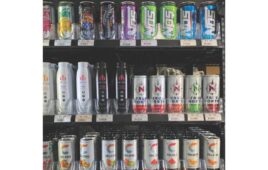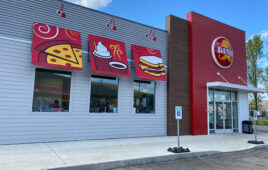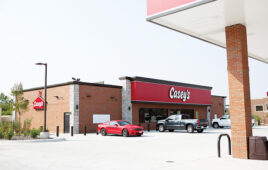Innovation abounds in packaged beverages as crossover between segments can cause confusion in the cold vault.
By Erin Rigik Del Conte, Senior Editor
Consumers continue to demand healthier beverages as they move away from sugary drinks, but innovation continues across the beverage spectrum including among more indulgent flavors and appeals. As innovation grows, the lines between beverage segments are beginning to overlap.
“It seems as more time goes by we are seeing decreased sales of the traditional ‘pop,’” said De Lone Wilson, president of Cubby’s Inc., who said sales dollars that once went to carbonated soft drinks are being spread across different beverage segments.
“Water is up some, different teas are up some, energy is up some,” Wilson said.
Indeed, carbonated beverage dollar sales fell 0.11% for the 52 weeks ending Sept. 4, according to total U.S. c-store data from market research firm IRI. Ready-to-drink (RTD) teas rose 7%, while energy drinks grew 5.02%, sports drinks climbed 6.62% and bottled water soared 8.42%.
Manufacturers continue to roll out new offerings in an attempt to gain ground in the still-profitable carbonated soft drink arena. For instance, Monster Beverage this summer introduced the “super soda” Mutant, a high-caffeine challenger to Mountain Dew. However, just as quickly as manufacturers are introducing new product lines consumers are seeking out the next new thing, causing market figures to fluctuate.
“Some of the growth that we did see in carbonated soft drinks (CSDs) over the last year really have eroded,” said Jordan Rost, vice president of consumer insights for the U.S. market, Nielsen. “A lot of the growth has shifted into some of these different varieties of beverages that deliver a similar experience.”
Rost pointed to sparkling water, which features carbonation but also a healthier appeal, and energy drinks, which in most cases offers carbonation but also an indulgent taste.
“There’s growth in the number of different options and varieties consumers have to choose from, many of which are growing quite a bit faster than even what we saw last year or years prior with soft drinks,” Rost added.
To meet the demand for various beverages Cubby’s stores in Nebraska, Iowa and South Dakota have added two or more ice bins or “troughs” to showcase iced bottled water, energy drinks and ready-to-drink teas. Cubby’s has also added boxed water—water packaged in a cardboard milk carton. The carton features a higher price point than regular bottled water, but that hasn’t stopped customers from buying it. The cartons did “pretty well” in two-thirds of stores, Wilson said. He credited the novelty of container and its environmentally-friendly attributes.
“People see it and laugh, and then they buy it,” Wilson said.
Rost noted that the growth of bottled water sales is being driven by consumer demand for healthy drinks on the go. “At the same time it is part of a larger shift towards cleaner beverages and healthier or natural beverages,” he said.
At Jay Petroleum Inc.’s 34 Pak-A-Sak locations throughout east central Indiana and west central Ohio, water sales have also soared.
“Water and energy drinks are our star performers for 2016,” said Gary Tabor, director of marketing and sales, Pak-A-Sak. “We went to an everyday low price, ‘twofer’ deal on energy drinks that really paid off.” Meanwhile teas and juices have “leveled off. ”
Tabor continues to see carbonated soft drinks decline, noting the segment is down 5.3% year-to-date.
BLURRED LINES
Meanwhile, segment crossover is driving consumer interest in the beverage category but also causing confusion.
“Continued innovation is putting a lot of stress on our cooler space allocation,” Tabor said, noting that the blurring of various beverage segments is lending to the problem.
He pointed to a number of products that straddle segments, including energy drinks that feature protein. “This crosses between protein and energy, but they want it in the milk door.” Sparkling water is another example: “Is that carbonated or water?” Enhanced waters also cross beverage segments.
“I think sometimes manufacturers blur the segment lines intentionally to gain more space,” Tabor said.
Despite the continued innovation, Pak-A-Sak does not plan any category space adjustments in 2017. The chain already adjusted cooler space last year following a strong analysis of the beverage category. Sales have remained similar, other than a “jump in energy and water,” each of which already comprises a full cooler door.
Rost also sees the blurring of beverage segments as a continuing trend. According to Nielsen total U.S. convenience store data for the 52 weeks ending Aug. 27, 2016 alternative beverages rose 5.4% over last year. Packaged beverages as a whole were up 4.3% for the same period.
“In some cases these ‘alternative beverages’ are blended varieties where you do start to see a blend between what’s a tea and what’s an energy drink and other overlaps. There is lot of innovation happening, particularly in that sort of patch-all category that encompasses many of these different types of varieties,” Rost said.
Rost’s advice to retailers is to anticipate the intent behind consumer beverage choices. “Provide a bit of transparency about the relationship between different beverages you’re stocking next to one another to help consumers make the choice that’s right for them.”
TIME FOR TEA
At Green Zebra, based in Portland, Ore., kombucha, a fermented tea that boasts health benefits, is most popular with the local people, who frequent its three c-stores.
“We currently carry Townshend’s, GT’s (original and classic), Health Ade, Kevita and Mamma Chia lines in the bottle, and we have six taps at our Lloyd location and four taps at our Kenton location for our local vendors,” said Andrew Weymouth, grocery director for Green Zebra.
On-tap kombucha is consistently at the top 10 for Green Zebra’s “Chill department” at both stores.
“The bottled kombucha is up, but it doesn’t meet the momentum of the on tap,” Weymouth said. However, he added that the bottles are a more familiar introduction of kombucha to customers that lends to them finding and regularly purchasing the on-tap product.
The popularity of kombucha in certain regions, Rost noted, is indicative of a larger trend: an overall openness to new and different flavor profiles, as well as a shift toward ‘food as medicine’ thinking.
“That really has accounted for a lot of the appeal of kombucha and other teas that have seen a surge in popularity,” Rost said.
Rost said that while people are willing to experiment with new flavors, those may vary between regions. “On the whole people really are gravitating towards new varieties and some of those are new flavors of teas,” he said.
Another up and coming beverage flavor option is spicy.
It’s no surprise new flavor profiles are intriguing to customers. Taste remains a major factor in beverage purchases. Some 84% of consumers indicated that taste drives their purchase decisions when it comes to beverages, according to Chicago-based research firm Mintel’s “Beverage Packaging Trends U.S., June 2016” report.
The second two factors that affected purchase decisions were high quality (67%) and fresh (67%). The report further noted that when asked what the strongest indicators of quality in beverage packaging were, respondents said chilled, glass, resealable and clear containers, all of which also contribute to freshness.




